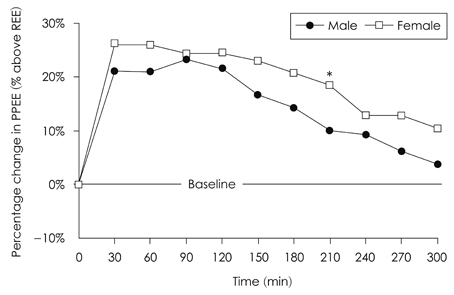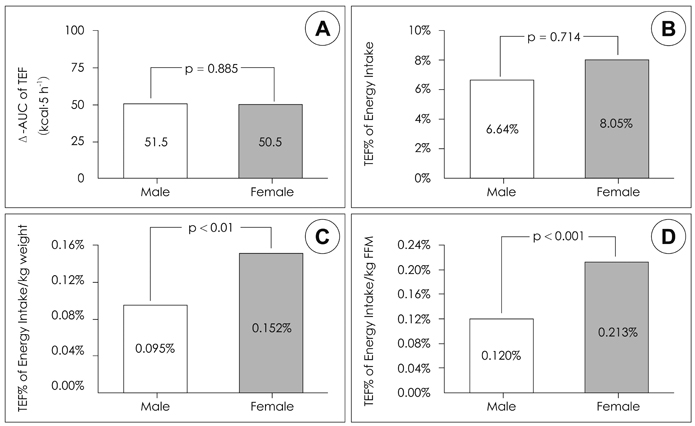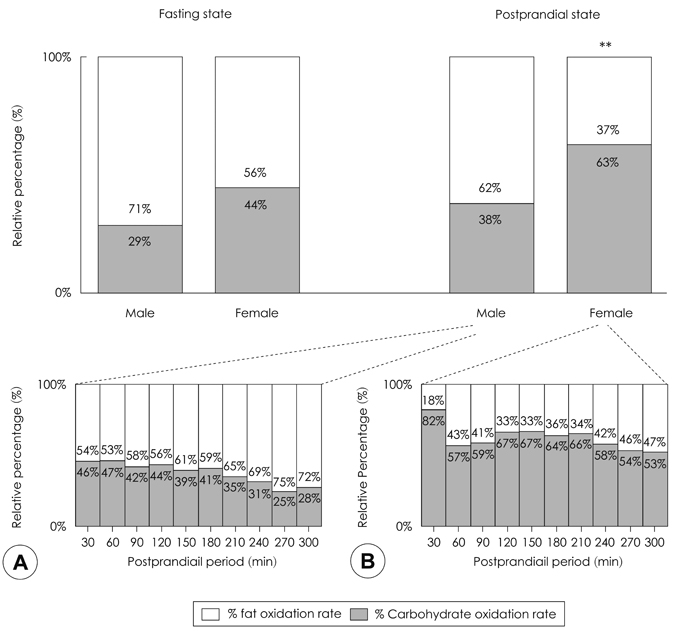Korean J Nutr.
2011 Dec;44(6):507-517. 10.4163/kjn.2011.44.6.507.
Thermic Effect of Food and Macronutrient Oxidation Rate in Men and Women after Consumption of a Mixed Meal
- Affiliations
-
- 1Department of Food and Nutrition, Gangneung-Wonju National University, Gangneung 210-742, Korea. ekkim@gwnu.ac.kr
- KMID: 2268611
- DOI: http://doi.org/10.4163/kjn.2011.44.6.507
Abstract
- The purpose of this study was to investigate the effects of gender on the thermic effect of food and substrate oxidation rate during 5 hours after a mixed meal. Twenty healthy college students (10 males and 10 females) aged 20-26 years participated in this study. The energy contents of the experimental diets were 775 kcal and 627 kcal for males and females respectively, which were 30% of individual energy requirements and were composed of 65/15/20% as the proportion of carbohydrate/protein/fat. Resting and postprandial energy expenditure and substrate oxidation rates were measured with indirect calorimetry in the fasting state and every 30 min for 5 hours after meal consumption. Thermic effects of food expressed as DeltaAUC and TEF% were not significantly different between males and females. However, TEF% adjusted for body weight and fat-free mass in males (0.095% and 0.120%) were significantly lower than those in females (0.152% and 0.213%)(p < 0.05). The total amount of carbohydrate oxidized was significantly lower in males than that in females (58.6 vs. 86.6 mg/kcal energy intake/5 h, p < 0.05). In contrast, the total amount of fat oxidized was significantly higher in males than that in females after the meal (32.9 vs. 17.2 mg/kcal energy intake/5 h, p < 0.01). These results indicate that gender affects the thermic effects of food and the substrate oxidation rate after a meal. The results show that males use relatively less carbohydrate and more fat as an energy source after a meal than that of females.
Figure
Reference
-
1. Obesity and overweight. World Health Organization. 2011. Available from: http://www.who.int/mediacentre/factsheets/fs311/en/.2. Ministry of Health and Welfare. Korea Centers for Disease Control and Prevention. Korea Health Statistics 2009: Korea National Health and Nutrition Examination Survey (KNHANES IV-3). 2010.3. Ministry of Health and Welfare. Korea Centers for Disease Control and Prevention. Korea Health Statistics 2005: Korea National Health and Nutrition Examination Survey (KNHANES III). 2006.4. Lönnqvist F, Thörne A, Large V, Arner P. Sex differences in visceral fat lipolysis and metabolic complications of obesity. Arterioscler Thromb Vasc Biol. 1997. 17(7):1472–1480.
Article5. Wajchenberg BL. Subcutaneous and visceral adipose tissue: their relation to the metabolic syndrome. Endocr Rev. 2000. 21(6):697–738.
Article6. Chumlea WC, Guo SS, Kuczmarski RJ, Flegal KM, Johnson CL, Heymsfield SB, Lukaski HC, Friedl K, Hubbard VS. Body composition estimates from NHANES III bioelectrical impedance data. Int J Obes Relat Metab Disord. 2002. 26(12):1596–1609.
Article7. Pietrobelli A, Allison DB, Heshka S, Heo M, Wang ZM, Bertkau A, Laferrère B, Rosenbaum M, Aloia JF, Pi-Sunyer FX, Heymsfield SB. Sexual dimorphism in the energy content of weight change. Int J Obes Relat Metab Disord. 2002. 26(10):1339–1348.
Article8. Greeno CG, Wing RR. Stress-induced eating. Psychol Bull. 1994. 115(3):444–464.
Article9. Choi SH, Jo MW, Shin DS. Effects of the 8-week resistance exercise on body composition, serum hormone profiles and feeding patterns of obese females. Korean J Nutr. 2004. 37(10):888–898.10. The Korean Nutrition Society. Dietary reference intakes for Koreans. 2010. 1st revision. Seoul:11. Schutz Y, Bessard T, Jèquier E. Diet-induced thermogenesis measured over a whole day in obese and nonobese women. Am J Clin Nutr. 1984. 40(3):542–552.
Article12. Granata GP, Brandon LJ. The thermic effect of food and obesity: discrepant results and methodological variations. Nutr Rev. 2002. 60(8):223–233.
Article13. Tentolouris N, Pavlatos S, Kokkinos A, Perrea D, Pagoni S, Katsilambros N. Diet-induced thermogenesis and substrate oxidation are not different between lean and obese women after two different isocaloric meals, one rich in protein and one rich in fat. Metabolism. 2008. 57(3):313–320.
Article14. Wu BN, O'Sullivan AJ. Sex differences in energy metabolism need to be considered with lifestyle modifications in humans. J Nutr Metab. 2011. 2011:391809. Epub 2011 Jun 6. doi: 10.1155/2011/391809.
Article15. Jensen MD. Gender differences in regional fatty acid metabolism before and after meal ingestion. J Clin Invest. 1995. 96(5):2297–2303.
Article16. Uranga AP, Levine J, Jensen M. Isotope tracer measures of meal fatty acid metabolism: reproducibility and effects of the menstrual cycle. Am J Physiol Endocrinol Metab. 2005. 288(3):E547–E555.
Article17. Karst H, Steiniger J, Noack R, Steglich HD. Diet-induced thermogenesis in man: thermic effects of single proteins, carbohydrates and fats depending on their energy amount. Ann Nutr Metab. 1984. 28(4):245–252.
Article18. Zhou BF, Stamler J, Dennis B, Moag-Stahlberg A, Okuda N, Robertson C, Zhao L, Chan Q, Elliott P. INTERMAP Research Group. Nutrient intakes of middle-aged men and women in China, Japan, United Kingdom, and United States in the late 1990s: the INTERMAP study. J Hum Hypertens. 2003. 17(9):623–630.
Article19. DuBois D, DuBois EF. Fifth paper the measurement of the surface area of man. Arch Intern Med. 1915. 15:868–881.
Article20. Compher C, Frankenfield D, Keim N, Roth-Yousey L. INTERMAP Research Group. Best practice methods to apply to measurement of resting metabolic rate in adults: a systematic review. J Am Diet Assoc. 2006. 106(6):881–903.
Article21. Weir JB. New methods for calculating metabolic rate with special reference to protein metabolism. J Physiol. 1949. 109(1-2):1–9.
Article22. Westerterp-Plantenga M, Diepvens K, Joosen AM, Bérubé-Parent S, Tremblay A. Metabolic effects of spices, teas, and caffeine. Physiol Behav. 2006. 89(1):85–91.
Article23. Oh SH, Park JJ, Choi IS, Ro HK. Effects of cellulose and pectin on diet-induced thermogenesis in young women. J Korean Soc Food Sci Nutr. 2007. 36(2):194–200.
Article24. Matthews JN, Altman DG, Campbell MJ, Royston P. Analysis of serial measurements in medical research. BMJ. 1990. 300(6719):230–235.
Article25. Segal KR, Edaño A, Blando L, Pi-Sunyer FX. Comparison of thermic effects of constant and relative caloric loads in lean and obese men. Am J Clin Nutr. 1990. 51(1):14–21.
Article26. Reed GW, Hill JO. Measuring the thermic effect of food. Am J Clin Nutr. 1996. 63(2):164–169.
Article27. Péronnet F, Massicotte D. Table of nonprotein respiratory quotient: an update. Can J Sport Sci. 1991. 16(1):23–29.28. McGilvery RW, Goldstein G. Biochemistry. A functional approach. 1983. Philadelphia: Saunders;810–976.29. Webb P. Energy expenditure and fat-free mass in men and women. Am J Clin Nutr. 1981. 34(9):1816–1826.
Article30. Park JA, Kim KJ, Kim JH, Park YS, Koo J, Yoon JS. A comparison of the resting energy expenditure of Korean adults using indirect calorimetry. Korean J Community Nutr. 2003. 8(6):993–1000.31. Lee GH, Kim MH, Kim EK. Accuracy of predictive equations for resting metabolic rate in Korean college students. Korean J Community Nutr. 2009. 14(4):462–473.32. Levine JA. Measurement of energy expenditure. Public Health Nutr. 2005. 8(7A):1123–1132.
Article33. Weststrate JA. Resting metabolic rate and diet-induced thermogenesis: a methodological reappraisal. Am J Clin Nutr. 1993. 58(5):592–601.
Article34. Visser M, Deurenberg P, van Staveren WA, Hautvast JG. Resting metabolic rate and diet-induced thermogenesis in young and elderly subjects: relationship with body composition, fat distribution, and physical activity level. Am J Clin Nutr. 1995. 61(4):772–778.
Article35. Ro HK, Choi IS, Oh SH. Effects of high carbohydrate, high fat and protein meal on postprandial thermogenesis in young women. J Korean Soc Food Sci Nutr. 2005. 34(8):1202–1209.
Article36. Jéquier E, Acheson K, Schutz Y. Assessment of energy expenditure and fuel utilization in man. Annu Rev Nutr. 1987. 7:187–120.
Article37. Flatt JP, Ravussin E, Acheson KJ, Jéquier E. Effects of dietary fat on postprandial substrate oxidation and on carbohydrate and fat balances. J Clin Invest. 1985. 76(3):1019–1024.
Article38. Schutz Y, Flatt JP, Jéquier E. Failure of dietary fat intake to promote fat oxidation: a factor favoring the development of obesity. Am J Clin Nutr. 1989. 50(2):307–314.
Article39. Koutsari C, Sidossis LS. Effect of isoenergetic low- and high-carbohydrate diets on substrate kinetics and oxidation in healthy men. Br J Nutr. 2003. 90(2):413–418.
Article40. Sidossis LS, Wolfe RR. Glucose and insulin-induced inhibition of fatty acid oxidation: the glucose-fatty acid cycle reversed. Am J Physiol. 1996. 270(4 Pt 1):E733–E738.
Article
- Full Text Links
- Actions
-
Cited
- CITED
-
- Close
- Share
- Similar articles
-
- Thermic Effect of Food, Macronutrient Oxidation Rate and Satiety of Medium-chain Triglyceride
- Thermic Effect of Food, Macronutrient Oxidation Rate and Satiety of High-fat Meals with Butter and Sesame Oil on Healthy Adults
- Effect of Pre-meal Water Consumption on Energy Intake and Satiety in Non-obese Young Adults
- Energy intake and snack choice by the meal patterns of employed people
- Diet status of college students evaluated by applying the photographic analysis method





